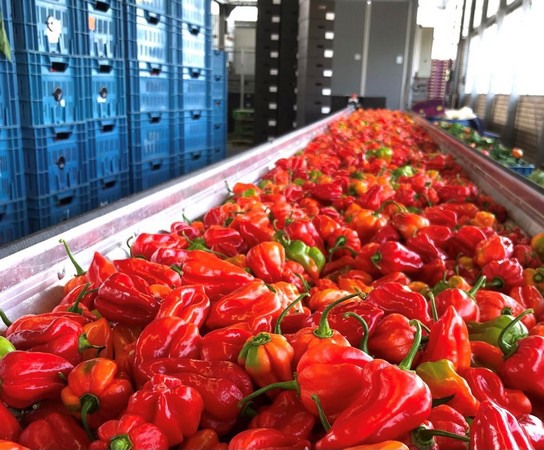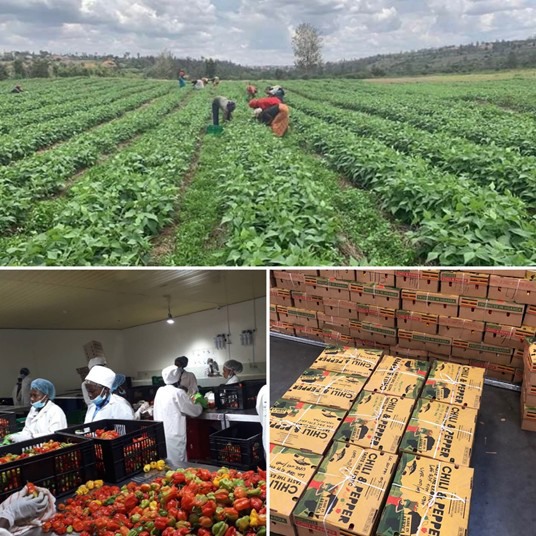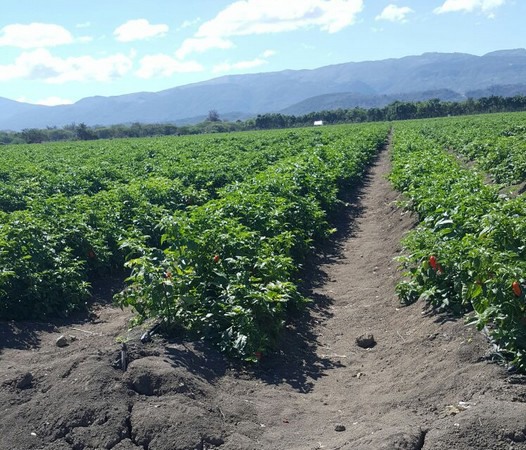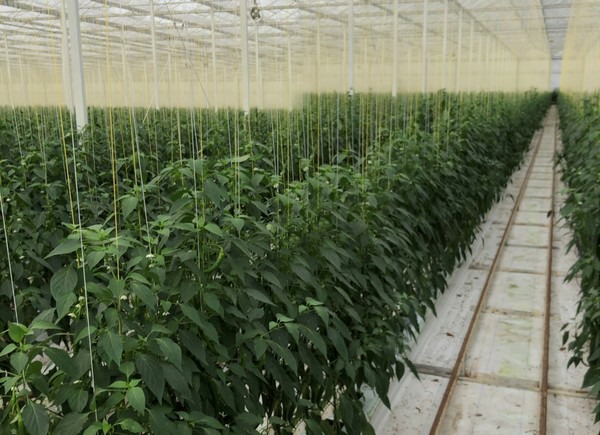In the ten years that Hamid Haddouch has been in the pepper business, he has not yet experienced that the Dutch habanero peppers cultivated in greenhouses are so early. Better techniques and knowledge ensure that good quality peppers can be harvested earlier. This means that Hamid and his company Chili & Pepper can start with their own product from week 12. “I expect a good season, especially the beginning, because imports from other countries are currently falling.”
More Dutch supply
The first exotic chili peppers in Dutch greenhouses are already being harvested. Hamid has seen the chili pepper cultivation in the Netherlands grow considerably in the last four to five years. “Especially because a number of growers have grown considerably in acreage,” he says. Hamid is proud that he and a handful of competitors have been able to give Dutch habanero peppers a place on the European market. “It is a niche product but quality knows no limits.”
Hamid cultivated peppers in Morocco until a few years ago. “We switched to Dutch chili peppers. These are high-quality peppers with a longer shelf life than peppers that are imported.”
 Export ban Uganda
Export ban Uganda
Hamid also has imported peppers in his product range. His company specializes in habanero peppers of different colors, but he also supplies spicier varieties such as Naga peppers, bird's eye chili, and the famous Carolina Reaper. From April to November from Dutch greenhouses, but year-round also from Morocco and Uganda, a large pepper producer. "There, close to the equator, the weather conditions are good for growing peppers year-round.”
Last year, imports from the African country proved difficult. "2020 was a difficult year", Hamid summarizes. Of course, there was the coronavirus, but at first an export ban on peppers from Uganda interfered with the trade in peppers because of the African codling moth. “The whole export stopped. As a result, everyone wanted habanero peppers, prices doubled and at one point habanero peppers were almost impossible to find.”
 Imports still difficult
Imports still difficult
Prices were good here as soon as the Dutch season started. “Demand was really high. Fortunately, supply was good. You can see that customers appreciate the quality of perhaps the most beautiful peppers in the world from Dutch greenhouses.”
This winter, importing from Uganda was once again possible. However, inspections are a lot stricter, Hamid notices. "Locally, many shipments are being rejected. Every shipment has to go through a phytosanitary inspection. Many exporters are also not allowed to ship until all things are in order. In addition, you have the regular inspections on residues of plant protection products. It is currently not very easy to import chili peppers," says Hamid. “Not to mention the increase in the prices for air freight because of the coronavirus.”
Stocking up on habanero peppers
Because of the coronavirus, fewer aircraft are flying, and that also affects the trade in chili peppers, for which cargo space in passenger aircraft is used. Moreover, the pandemic also affects the sales outlets for peppers, although Hamid sees differences between the varieties of peppers. "For us, the habanero pepper is our biggest product. Last year, you saw that people started stocking up on habanero peppers and after that sales remained good. This is because we mainly supply (Asian) supermarkets throughout Europe.”
For other types of peppers, this was different. These are often used in the hospitality industry, for example baby bell peppers. "Sales were much more difficult there and last year you had surpluses.”
Good start expected
December is a festive month with usually a good demand for chili peppers. However, past December was not that good, also for Hamid and his business. “During the second coronavirus wave, consumers were more specific in what they bought, instead of shopping for the holidays, which seemed to reduce the amount of peppers they bought in the store.”
Yet Hamid is positive about the starting Dutch chili pepper season. This is because the supply from other countries is decreasing. “You can see that there are some countries that have problems with drought and that cultivation is coming to an end there.”
It will be summer before the larger quantities from other European countries come on the market. Until then, Hamid foresees a good chili pepper season. “It is nice that in the Netherlands the knowledge of this cultivation has increased so much that we can supply the whole of Europe, even early in the season, with very good quality peppers, thanks to the growers.”
Matter of taste
Despite this, some customers want Ugandan peppers, even in the coming months. According to Hamid, this is due to the specific taste of this product. “The conditions in Uganda give the product a distinct taste that is different from peppers cultivated in a greenhouse. Those peppers are also spicy, but it's different because you're missing flavor. For example, in Germany, some customers ask for Ugandan chili peppers year-round.”
 Brexit costs
Brexit costs
Another major market for chili peppers is the United Kingdom. “Here they like really spicy peppers. Especially when there was a shortage of habanero peppers last year, we sold many even spicier peppers to the British.”
Whether that will happen again this season is still a question. Brexit is now a fact. "We were immediately up to a good start exporting to the United Kingdom, but you can see that the costs are rising. If the phytosanitary requirements become even stricter, the costs will increase even further. That does mean that you have to have serious quantities for this niche product if you want to be profitable. We bear the administrative burden and costs for our customers, but for a single pallet this becomes difficult. The British also import directly from exporting countries.”
 Fortunately, in the Netherlands, the chili pepper is also gaining recognition. And with that also Dutch cultivation, which starts earlier every year. For Hamid, it is now time to market home-grown chili peppers under its brand Chili & Pepper, possibly together with other types of fruit and vegetables. “For example, we also do a lot of yams from Ghana, plantains, and okra. We also have the necessary customers for those products,” he concludes.
Fortunately, in the Netherlands, the chili pepper is also gaining recognition. And with that also Dutch cultivation, which starts earlier every year. For Hamid, it is now time to market home-grown chili peppers under its brand Chili & Pepper, possibly together with other types of fruit and vegetables. “For example, we also do a lot of yams from Ghana, plantains, and okra. We also have the necessary customers for those products,” he concludes.
For more information:
Chili & Pepper The Netherlands
www.chili-pepper.nl
Hamid Haddouch
hamid@chili-pepper.nl
